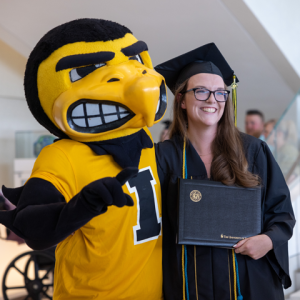Table of ContentsClose

News briefs
The search for the next associate vice president and CEO of University of Iowa Hospitals & Clinics is underway.
Colin Derdeyn, MD, chair and departmental executive officer of the UI Department of Radiology, and Peter Matthes, UI senior advisor to the president and vice president for external affairs, will serve as co-chairs of the search committee, which consists of 10 UI faculty and staff members.
The new associate vice president and CEO will report to Denise Jamieson, MD, MPH, UI vice president for medical affairs and the Tyrone D. Artz Dean of the Carver College of Medicine.
This position is currently led on an interim basis by Kimberly Hunter, DNP, MBA, RN, NEA-BC, chief nurse executive of UI Hospitals & Clinics. She was appointed to this position in 2022 after Suresh Gunasekaran, MBA, departed to lead University of California San Francisco Health.

In its 2024 edition of “Best Graduate Schools,” U.S. News & World Report ranks the Carver College of Medicine in the following categories:
-
Physician Assistant: No. 2
-
Primary Care: No. 19
-
Most Graduates Practicing in Rural Areas: No. 37
-
Research: No. 44
-
Most Graduates Practicing in Primary Care Fields: No. 76
-
Most Diverse Medical Schools: No. 92
-
Most Graduates Practicing in Medically Underserved Areas: No. 94
The Department of Physical Therapy and Rehabilitation Science keeps its No. 4 position from the 2021 rankings (released in 2020). Updated rankings for physical therapy programs were not compiled for the 2024 “Best Graduate Schools” listings.

University of Iowa Hospitals & Clinics continues to receive national recognition with seven specialties included in the 2023–24 “Best Hospitals” rankings published by U.S. News & World Report.
UI Hospitals & Clinics—ranked by U.S. News as Iowa’s No. 1 hospital—ranked in two specialties:
- Ophthalmology: No. 6
- Ear, nose, and throat: No. 28
Five specialties were also designated as high-performing, which places them in the top 10% of hospitals across the country:
Additionally, UI Stead Family Children’s Hospital is included among the nation’s best medical centers in six pediatric specialties:
- Neonatology: No. 21
- Pediatric diabetes and endocrinology: No. 23
- Pediatric orthopedics: No. 28
- Pediatric nephrology: No. 42
- Pediatric neurology and neurosurgery: No. 47
- Pediatric urology: No. 48
The “Best Children’s Hospitals” rankings also include state and multistate regional rankings. UI Stead Family Children’s Hospital ranks as the No. 1 children’s hospital in Iowa and No. 11 in the Midwest region.


When neonatologists Patrick McNamara, MD, and Regan Giesinger, MD, started the hemodynamic screening program at University of Iowa Stead Family Children’s Hospital in 2017, they aimed to increase survival rates and reduce complications for preterm babies.
Now, a new study is showing promising results.
The study—published in the May edition of the American Journal of Respiratory and Critical Care Medicine—shows that when hemodynamic screening was completed 24 hours after the birth of babies born at fewer than 27 weeks of gestation, the combined rate of death or severe brain bleeding fell by half. Hemodynamic screening was also linked to a lower incidence of several other complications such as severe lung disease and necrotizing enterocolitis.
Hemodynamics involves using ultrasound to obtain detailed images of a baby’s heart, valves, and vessels, which allows doctors to assess heart function and blood flow to all parts of the body.
“This work is precedent-setting for neonatology,” says McNamara, professor of pediatrics and director of the Division of Neonatology.
The UI team followed 423 babies, born before 27 weeks, between January 2010 and December 2017. This control group did not get hemodynamic screening and is representative of the situation at most high-level NICUs in the U.S. They also followed 191 babies, also born before 27 weeks, between October 2018 and April 2022. All these babies received hemodynamic screening 12 to 18 hours after birth.
The hemodynamic screening group had lower levels of all the adverse events measured: severe brain bleeding, death, death within the first week of life, necrotizing enterocolitis, and severe bronchopulmonary dysplasia.
Editor’s note: Giesinger died in May 2023. Her last study “provided landmark findings that will have a huge impact on the care of these tiny babies in the future,” McNamara says.

Atrial fibrillation (AFib) is the most common type of heart arrhythmia and can be dangerous if not diagnosed and treated effectively. Early diagnosis and treatment can help reduce the risk of stroke, heart failure, and other complications.
University of Iowa Health Care cardiac electrophysiologists offer several new treatments for patients who may have persistent symptoms, even after initial treatment. Paari Dominic, MBBS, MPH (12F), shares the following guidance for referring providers:
Convergent procedure
This hybrid approach combines minimally invasive heart surgery and a traditional catheter ablation to treat long-standing, persistent, or permanent AFib. It's one of the least invasive and most successful methods for surgically treating AFib that doesn’t improve with other treatments.
Candidates for convergent procedure:
-
Persistent AFib (lasts longer than 12 months without any intervening sinus rhythm)
-
Permanent AFib (sinus rhythm could not be restored, have symptoms of fatigue, shortness of breath, palpitations, chest pressure, dizziness, or light headedness)
-
Intolerance to AFib medications
-
Previous AFib treatments were unsuccessful
-
Underlying cardiomyopathy
Vein of Marshall ablation
This minimally invasive chemical ablation is for patients with persistent AFib. If AFib symptoms continue or become more persistent after a traditional AFib ablation, this option can be used to directly eliminate triggers.
Candidates for vein of Marshall ablation:
-
Recurrent AFib after a prior AFib ablation
-
Atrial flutter after an AFib ablation
-
Persistent but not long-standing persistent AFib
-
Co-existent cardiomyopathy or fatigue, shortness of breath, palpitations, chest pressure, dizziness, or lightheadedness
Ganglionated plexi ablation
Vagal nerve activity can sometimes trigger AFib. Additionally, patients who undergo an AFib ablation can have slow heart rates, often needing a pacemaker. For these reasons, ablation of the ganglionated plexi—nerves outside the wall of the left atrium in the left upper chamber of the heart—may prevent recurrence of AFib and increase basal heart rates after an ablation. This may prevent the need for a pacemaker.
Candidates for ganglionated plexi ablation:
-
Recurrent AFib after a prior AFib ablation
-
Persistent but not long-standing persistent AFib (underlying sinus rhythm is slower than 50 bpm)
-
Co-existent cardiomyopathy or fatigue, shortness of breath, palpitations, chest pressure, dizziness, or lightheadedness
In the news
The following are selected quotes featured in media outlets.
"You can even wear EEG electrodes while at home, driving, or sleeping. While it doesn’t have great spatial resolution, it has excellent temporal resolution and gives you a dynamic snapshot of brain activity. We thought that we could use this to learn something about Parkinson’s disease. This is one of the largest EEG studies of Parkinson’s disease that I am aware of.”
Nandakumar Narayanan, MD, PhD, associate professor of neurology, tells Medical News Today about a recent study published in the Journal of Neurology, Neurosurgery & Psychiatry in which his team found that EEG tests could help improve the diagnosis of cognitive decline in people with Parkinson’s and create new biomarkers that could be used to target therapies to treat the disease’s cognitive symptoms. Narayanan says he was “blown away” by the study's outcome.

"Even if you think you can give 100% effort, stop at 70% before you go on.”
Anureet Walia, MD (17F), a pain management specialist at UI Hospitals & Clinics, tells Today as a recommendation for those who have chronic pain. She says patients should set daily goals for what they want to accomplish—without overdoing it.

"Essentially, all tick bites carry the potential for disease transmission. However, there are harmless tick bites in the sense that the tick bite occurs, and the tick falls off or is removed without incident, including disease transmission.”
Nathan Shaw (11MD), family medicine physician at University of Iowa Hospitals & Clinics, tells Women’s Health Magazine about the varying risks that come with tick bites.

Paper trail
This is a small sample of notable manuscripts recently published by University of Iowa researchers.
Westin JR, Oluwole OO, Kersten MJ, Miklos DB, Perales MA, Ghobadi A, Rapoport AP, Sureda A, Jacobson CA, Farooq U, van Meerten T, Ulrickson M, Elsawy M, Leslie LA, Chaganti S, Dickinson M, Dorritie K, Reagan PM, McGuirk J, Song KW, Riedell PA, Minnema MC, Yang Y, Vardhanabhuti S, Filosto S, Cheng P, Shahani SA, Schupp M, To C, Locke FL; ZUMA-7 Investigators and Kite Members. Survival with Axicabtagene Ciloleucel in Large B-Cell Lymphoma. N Engl J Med. 2023 Jul 13;389(2):148-157. doi: 10.1056/NEJMoa2301665. Epub 2023 Jun 5.
Kohlmeyer JL, Lingo JJ, Kaemmer CA, Scherer A, Warrier A, Voigt E, Raygoza Garay JA, McGivney GR, Brockman QR, Tang A, Calizo A, Pollard K, Zhang X, Hirbe AC, Pratilas CA, Leidinger M, Breheny P, Chimenti MS, Sieren JC, Monga V, Tanas MR, Meyerholz DK, Darbro BW, Dodd RD, Quelle DE. CDK4/6-MEK inhibition in MPNSTs causes plasma cell infiltration, sensitization to PD-L1 blockade, and tumor regression. Clin Cancer Res. 2023 Jul 6:CCR-23-0749. doi: 10.1158/1078-0432.CCR-23-0749.
Alladina J, Smith NP, Kooistra T, Slowikowski K, Kernin IJ, Deguine J, Keen HL, Manakongtreecheep K, Tantivit J, Rahimi RA, Sheng SL, Nguyen ND, Haring AM, Giacona FL, Hariri LP, Xavier RJ, Luster AD, Villani AC, Cho JL, Medoff BD. A human model of asthma exacerbation reveals transcriptional programs and cell circuits specific to allergic asthma. Sci Immunol. 2023 May 12;8(83):eabq6352. doi: 10.1126/sciimmunol.abq6352. Epub 2023 May 5. PMID: 37146132.
